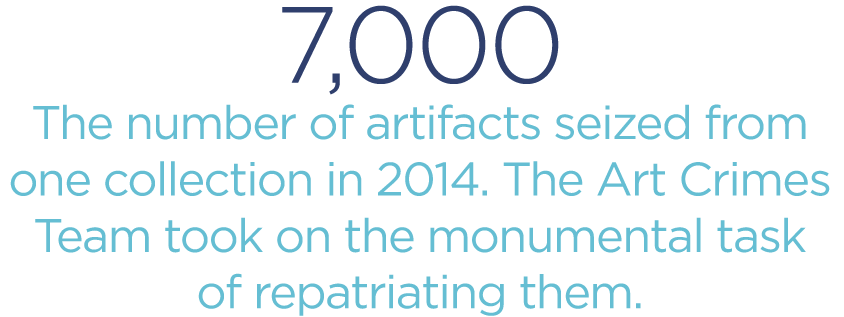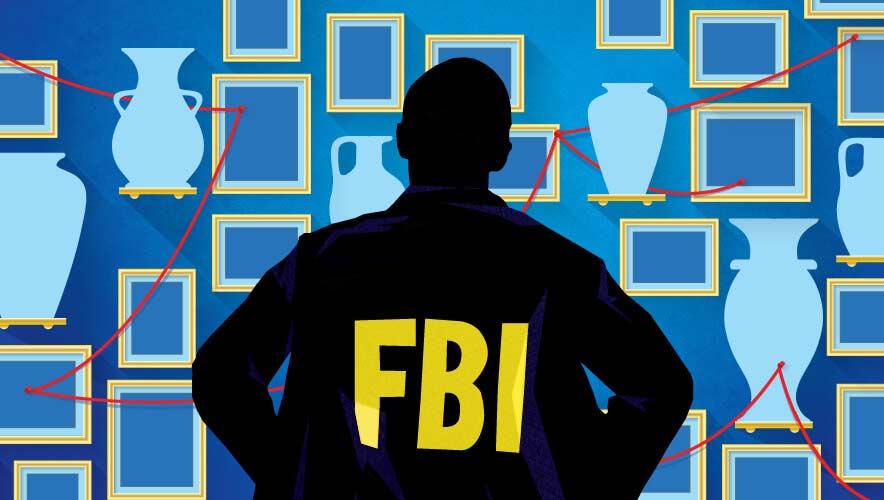The FBI Art Crime Team: Repatriation, One Antiquity at a Time
At 243 years old, the United States has some maturity. But occasionally the U.S. government experiences a first. This was the case in July 2016 when the U.S. Department of Justice filed its first action to forfeit an item of cultural patrimony from a European auction house.
The Acoma Pueblo tribe are one of 24 federally recognized Native American tribes in all or parts of the U.S. states of Colorado, New Mexico, and Texas. In May 2016, Acoma tribal leaders alerted the FBI that they had discovered that EVE Auction House in Paris, France, had included an Acoma ceremonial war shield in its auction catalog.
“The tribal member identified the photographs as depicting the exact shield her grandfather had used in cultural and religious ceremonies for the Pueblo,” according to a DOJ press release. “Her grandfather had held the position of traditional kiva leader and cultural practitioner with the Pueblo.”
The shield is more than 100 years old, and under Pueblo law, it cannot be destroyed, alienated, appropriated, or conveyed by anyone outside of the Pueblo. It’s unclear how the shield ended up in the Eve Auction House’s possession, but the U.S. government was determined to get it back.
So, it filed its action and in 2019 the auction house surrendered the shield to a special agent of the FBI’s Art Crime Team to safely transfer it back to its rightful owners.
This typically works the other way around, says Tim Carpenter, head of the FBI Art Crime Team based out of the Bureau’s headquarters in Washington, D.C. Usually, it’s the team repatriating an artifact from the United States back to its home elsewhere in the world.
The Art Crime Team is comprised of 24 agents, along with Carpenter, who take the lead or assist the FBI’s 56 field offices with cultural properties crime investigations. Team members come from all backgrounds, but they specialize in handling fine art and antiquities, evidence collection for these fragile items, and current trends in how they are trafficked and moved through the underground market.
The team is one of the larger law enforcement units in the world that focuses on art and antiquities crimes, but it is still relatively small and therefore relies heavily on partnerships with other agencies and the private sector to accomplish its work.
“We’re larger than many of our partner units across the world, but we’re not that big—we don’t have the resources to spend the day scouring the Internet for leads,” Carpenter adds. “Most of our cases come to us through referral; that’s what we have time to address.”
Typically, this works with someone reaching out to local authorities about a theft or a suspicious-seeming artifact that popped up on the art market. Those authorities can then alert the FBI, which loops in the Art Crimes Team to assist in an investigation and, in the case of a theft, return the artifact.

One major recent endeavor by the Art Crimes Team was repatriating 479 artifacts to the Republic of Haiti. An FBI operation led to the seizure of more than 7,000 items in 2014 from amateur archeologist Donald Miller’s private collection. Miller, who amassed the artifacts from various countries and displayed many of them in his home, relinquished the artifacts to the FBI, which then began the monumental task of returning them.
“It was an honor to do that as that was the first time that anyone had repatriated items back to Haiti,” Carpenter says. “It was world class. It was all museum quality, and we really helped them build out their national collection by returning them because they didn’t have examples of many of these materials.”
The COVID-19 pandemic complicated work like this because travel restrictions sometimes prevented members of the Art Crimes Team from escorting artifacts across borders.
For instance, in 2020 the team needed to repatriate nearly 130 artifacts to Papua New Guinea—also from Miller’s illegal collection—but could not provide an agent escort.
“We had to get really creative on how to get there,” Carpenter says.
In Papua New Guinea, U.S. Embassy personnel and staff from the National Museum and Gallery provided assistance and supervision with unpacking the returned pieces, Carpenter adds. The artifacts are now displayed as part of the museum’s collection.
Along with impacting repatriation efforts, COVID-19 also stalled some of the Art Crime Team’s training and partnership building. Normally amidst its investigations, team members travel around the world to host workshops and attend meetings to share best practices for investigations, evidence collection, and theft prevention with law enforcement agencies, museum curators, and security professionals. The pandemic led to the longest stretch of time in Carpenter’s government career that he has gone without traveling for the Bureau. “COVID has kicked us in the teeth on that front,” he adds.
“Where the rest of the world has transitioned to online platforms and virtual training, it’s hard to do what we do virtually,” Carpenter explains. “It’s hard to teach object handling, photography, evidence collection, crime scene management, those are concepts that are nigh impossible to do virtually.”
In the meantime, Carpenter says the team is devoted to continuing its investigatory work remotely, participating in the Cultural Heritage Committee, and engaging in virtual workshops with Interpol, the U.S. Department of Homeland Security, and the Smithsonian Institute.
Megan Gates is senior editor at Security Management. Connect with her at [email protected]. Follow her on Twitter: @mgngates.
